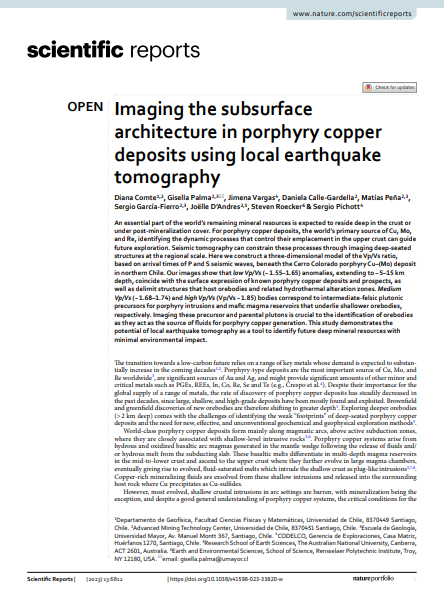Imaging the subsurface architecture in porphyry copper deposits using local earthquake tomography

Fecha
2023-04-26Autor
Comte, Diana
Palma, Gisella [Univ Mayor, Escuela Geol, Chile]
Vargas, Jimena
Calle-Gardella, Daniela
Peña, Matías [Univ Mayor, Escuela Geol, Chile]
García-Fierro, Sergio [Univ Mayor, Escuela Geol, Chile]
D'Andres, Joelle
Roecker, Steven
Pichott, Sergio
Ubicación geográfica
Notas
HERRAMIENTAS
Acceda a títulos restringidos
¿Cómo descargar?Resumen
An essential part of the world's remaining mineral resources is expected to reside deep in the crust or under post-mineralization cover. For porphyry copper deposits, the world's primary source of Cu, Mo, and Re, identifying the dynamic processes that control their emplacement in the upper crust can guide future exploration. Seismic tomography can constrain these processes through imaging deep-seated structures at the regional scale. Here we construct a three-dimensional model of the Vp/Vs ratio, based on arrival times of P and S seismic waves, beneath the Cerro Colorado porphyry Cu-(Mo) deposit in northern Chile. Our images show that low Vp/Vs (similar to 1.55-1.65) anomalies, extending to similar to 5-15 km depth, coincide with the surface expression of known porphyry copper deposits and prospects, as well as delimit structures that host orebodies and related hydrothermal alteration zones. Medium Vp/Vs (similar to 1.68-1.74) and high Vp/Vs (Vp/Vs similar to 1.85) bodies correspond to intermediate-felsic plutonic precursors for porphyry intrusions and mafic magma reservoirs that underlie shallower orebodies, respectively. Imaging these precursor and parental plutons is crucial to the identification of orebodies as they act as the source of fluids for porphyry copper generation. This study demonstrates the potential of local earthquake tomography as a tool to identify future deep mineral resources with minimal environmental impact.
URI
https://repositorio.umayor.cl/xmlui/handle/sibum/9503https://www.ncbi.nlm.nih.gov/pmc/articles/PMC10133302/pdf/41598_2023_Article_33820.pdf
https://doi.org/10.1038%2Fs41598-023-33820-w
https://www-nature-com.bibliotecadigital.umayor.cl:2443/articles/s41598-023-33820-w.pdf
Coleccion/es a la/s que pertenece:
Si usted es autor(a) de este documento y NO desea que su publicación tenga acceso público en este repositorio, por favor complete el formulario aquí.